

Mate
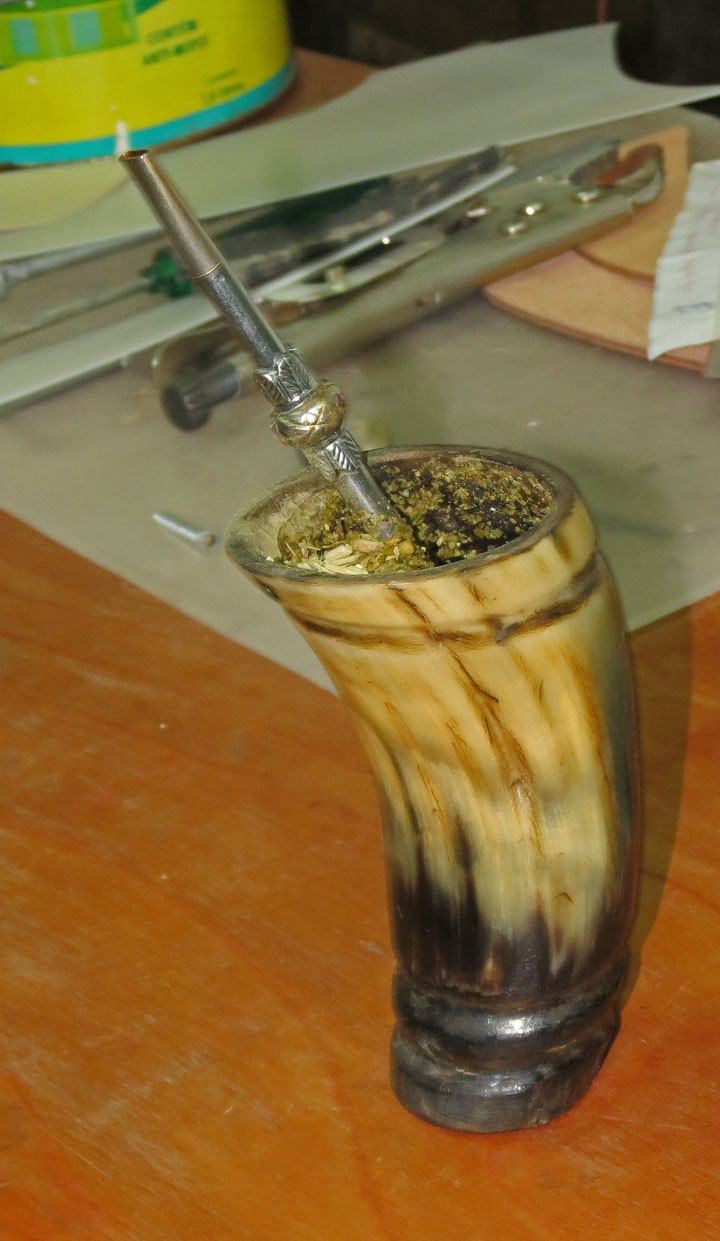
Yerba with hot water in the animal
horn bowl
with the metal straw
Mate, Portuguese, also known as
chimarrão or cimarrón, is a traditional South American infused drink,
particularly in Argentina, Uruguay, Paraguay, southern states of Brazil, south
of Chile, the Bolivian Chaco, and to some extent, Syria and Lebanon. It is
prepared from steeping dried leaves of yerba maté (llex paraguariensis, known in
Portuguese as erva mate) in hot water.
Mate is served with a metal straw from a shared hollow calabash gourd. The straw
is called a bombilla in some Latin American countries, a bomba in Portuguese,
and a bombija or, more generally, a masassa (type of straw) in Arabic. The straw
is traditionally made of silver. Modern, commercially available straws are
typically made of nickel silver, called Alpaca; stainless steel, or
hollow-stemmed cane. The gourd is known as a mate or a guampa; while in Brazil,
it has the specific name of cuia. Even if the water is supplied from a modern
thermos, the infusion is traditionally drunk from mates or cuias.
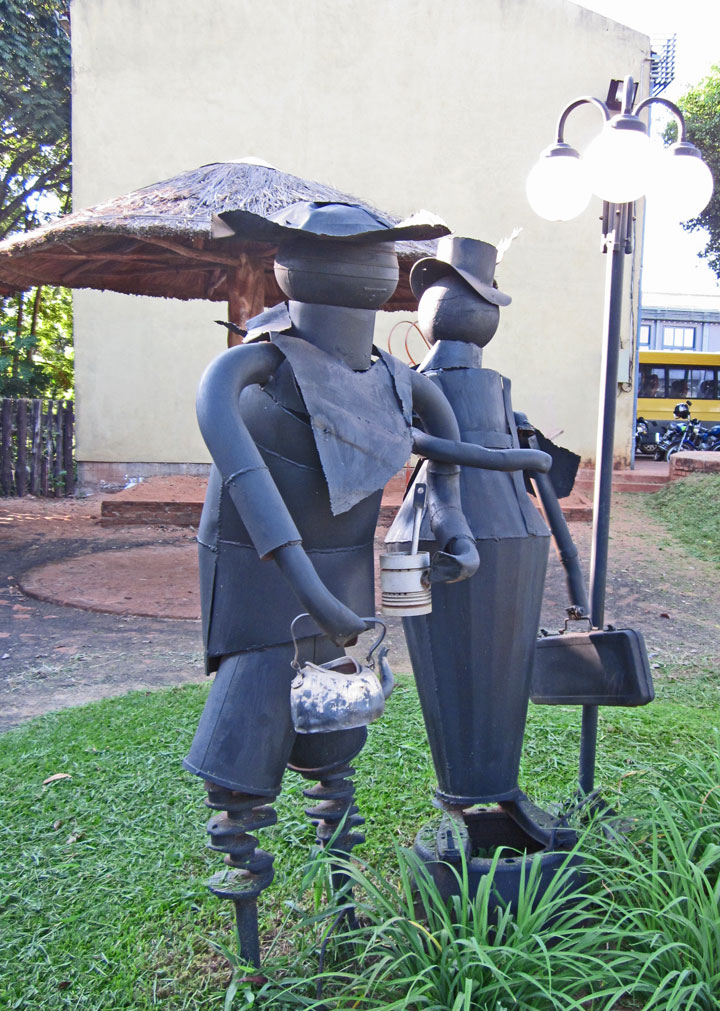
statues in Bella Vista of Mate consumers
As with other brewed herbs, yerba mate leaves are dried, chopped, and ground
into a powdery mixture called yerba. The bombilla acts as both a straw and a
sieve. The submerged end is flared, with small holes or slots that allow the
brewed liquid in, but block the chunky matter that makes up much of the mixture.
A modern bombilla design uses a straight tube with holes, or spring sleeve to
act as a sieve.
"Tea-bag" type infusions of mate (mate cocido) have been on the market in
Argentina, Paraguay and Uruguay for many years under such trade names as "Taragüí
Vitality" in Argentina, "Pajarito" and "Kurupí" in Paraguay, and in Brazil under
the name "Mate Leão". This is considered a completely different drink. It is
never drunk from cuias or called chimarrão, nor is it associated with the gaúcha
culture.
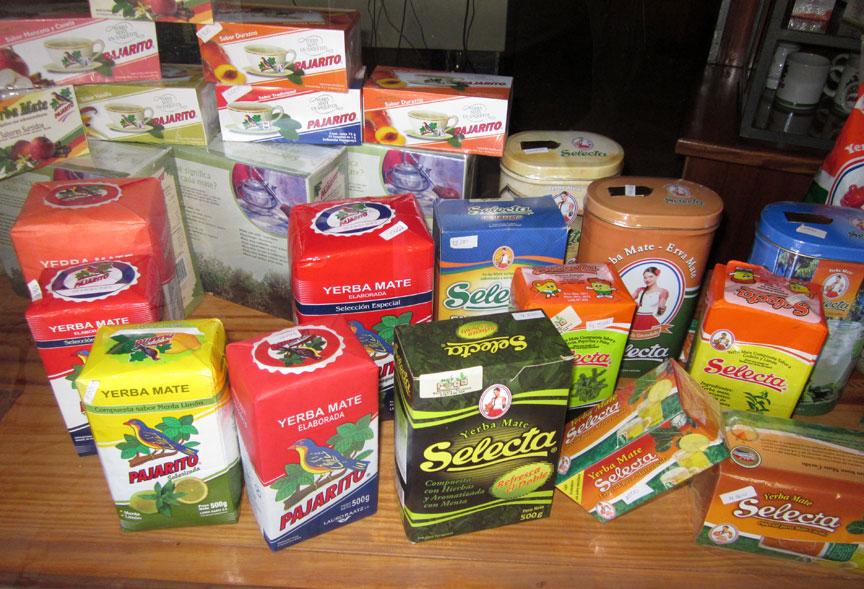
Yerba Mate products available
Both the spellings "mate" and "maté" are used in English. The acute accent on
the final letter is likely added as a hypercorrection, and serves to indicate
that the word and its pronunciation are distinct from the common English word
"mate". But, the Yerba Mate Association of the Americas states that it is always
incorrect to accent the second syllable, since this creates confusion with an
unrelated Spanish word for killing. ("Maté" literally means "I killed" in
Spanish).
In Brazil, traditionally prepared mate is known as chimarrão, although the word
mate and the expression "mate amargo" (bitter mate) are also used in Argentina
and Uruguay. The Spanish cimarrón means "rough", "brute", or "barbarian", but is
most widely understood to mean "feral", and is used in almost all of Latin
America for domesticated animals that have become wild. The word was then used
by the people who colonized the region of the Río de la Plata to describe the
natives' rough and sour drink, drunk with no other ingredient to soften the
taste.
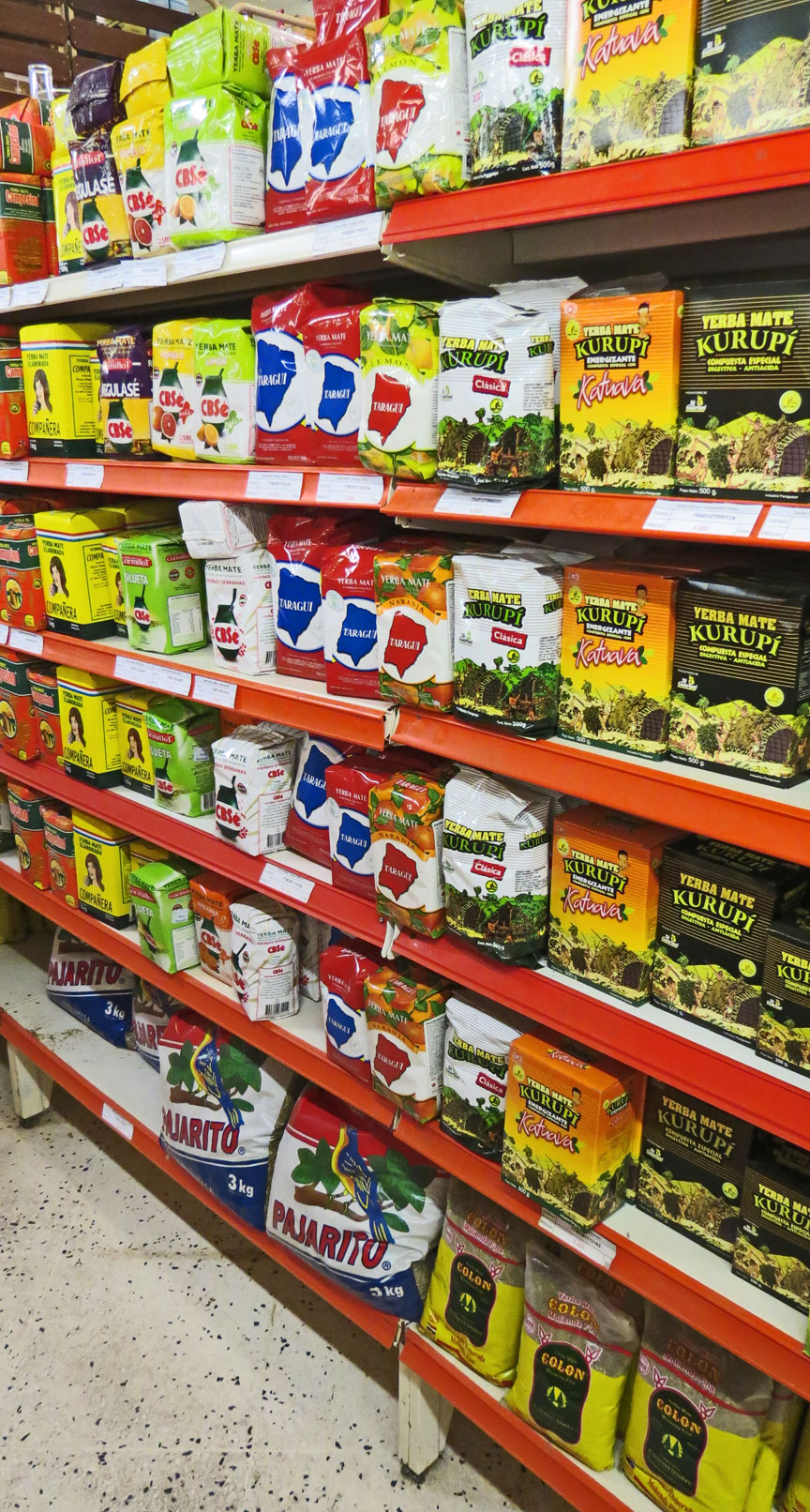
on the market shelf
The method of preparing the mate infusion varies considerably from region to
region, and which method yields the finest outcome is hotly debated. However,
nearly all methods have some common elements. The beverage is traditionally
prepared in the same gourd recipient, also called mate or guampa in Spanish and
cuia in Portuguese, in which it is drunk. The gourd is nearly filled with yerba,
and hot water (typically at 70–80 °C [160–180 °F], never boiling) is added.
The most common preparation involves a careful arrangement of the yerba within
the gourd before adding hot water. In this method, the gourd is first filled
one-half to three-quarters of the way with yerba. Too much yerba will result in
a "short" mate; conversely, too little yerba results in a "long" mate, both
being considered undesirable. After that, any additional herbs ("yuyo", in
Portuguese "jujo") may be added for either health or flavor benefits; a practice
most common in Paraguay, where people acquire herbs from a local yuyera
(herbalist) and use the mate as a base for their herbal infusions. When the
gourd is adequately filled, the preparer typically grasps it with the full hand,
covering and roughly sealing the opening with the palm. Then the mate is turned
upside-down, and shaken vigorously, but briefly and with gradually decreasing
force, in this inverted position. This causes the finest, most powdery particles
of the yerba to settle toward the preparer's palm and the top of the mate.
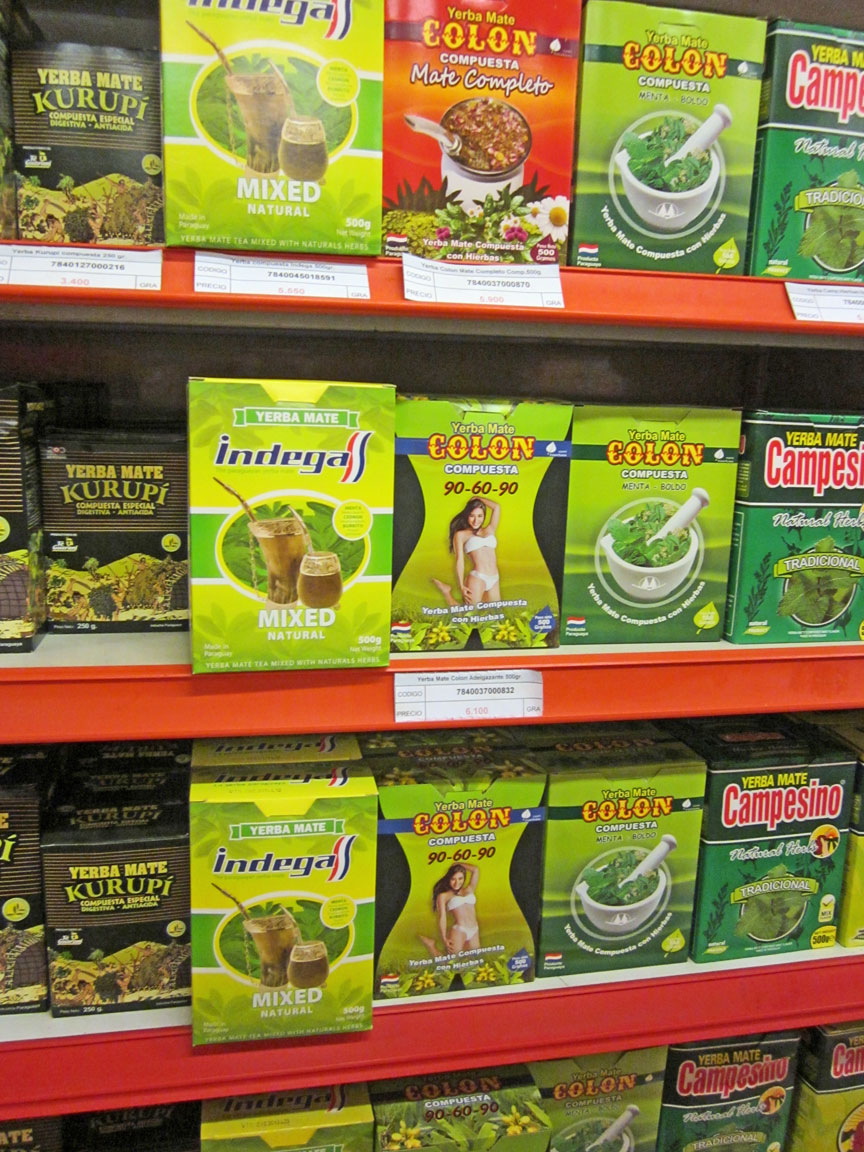
bikini helps the sale ?
Once the herb has settled, the mate is carefully brought to a near-sideways
angle, with the opening tilted just slightly upward of the base. The mate is
then shaken very gently with a side-to-side motion. This further settles the
herb inside the gourd so that the finest particles move toward the opening and
the yerba is layered along one side. The largest stems and other bits create a
partition between the empty space on one side of the gourd and the lopsided pile
of yerba on the other.
After arranging the yerba along one side of the gourd, the mate is carefully
tilted back onto its base, minimizing further disturbances of the yerba as it is
re-oriented to allow consumption. Some avalanche-like settling is normal, but is
not desirable. The angled mound of yerba should remain, with its powdery peak
still flat and mostly level with the top of the gourd. A layer of stems along
its slope will slide downward and accumulate in the space opposite the yerba
(though at least a portion should remain in place).

All of this careful settling of the yerba ensures that each sip contains as
little particulate matter as possible, creating a smooth-running mate. The
finest particles will then be as distant as possible from the filtering end of
the straw. With each draw, the smaller particles would inevitably move toward
the straw, but the larger particles and stems filter much of this out. A sloped
arrangement provides consistent concentration and flavor with each filling of
the mate.
Now the mate is ready to receive the straw. Many people choose to pour warm
water into the mate before adding the straw, while others insist that the straw
is best inserted into dry yerba. Wetting the yerba by gently pouring cool water
into the empty space within the gourd until the water nearly reaches the top,
and then allowing it to be absorbed into the yerba before adding the straw,
allows the preparer to carefully shape and "pack" the yerba's slope with the
straw's filtering end, which makes the overall form of the yerba within the
gourd more resilient and solid. Dry yerba, on the other hand, allows a cleaner
and easier insertion of the straw, though care must be taken so as not to overly
disturb the arrangement of the yerba. Such a decision is entirely a personal or
cultural preference. The straw is inserted with one's thumb on the upper end of
the straw, at an angle roughly perpendicular to the slope of the yerba, so that
its filtering end travels into the deepest part of the yerba and comes to rest
near or against the opposite wall of the gourd. It is important that the thumb
forms a seal over the end of the straw when it is being inserted, or the
negative pressure produced will draw in undesirable particulates.
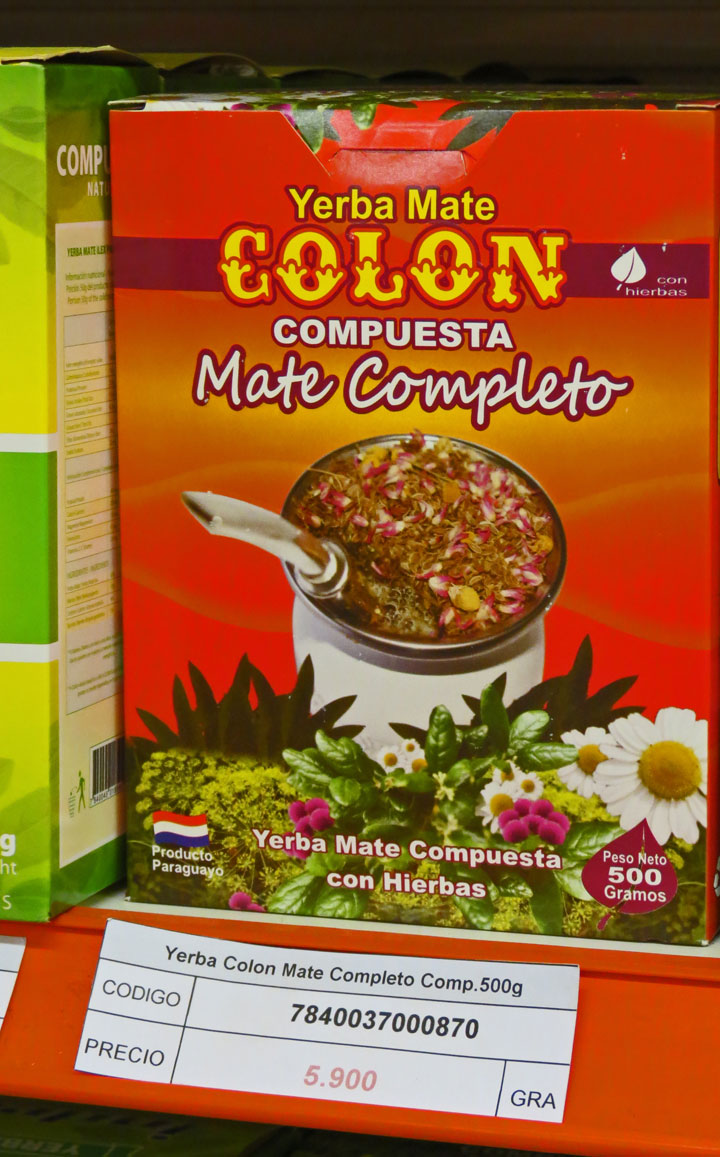
Now the yerba may be brewed. If the straw was inserted into dry yerba, the mate
must first be filled once with cool water as above, then be allowed to absorb it
completely (which generally takes no more than two or three minutes). Treating
the yerba with cool water before the addition of hot water is essential, as it
protects the herb from being scalded and from the chemical breakdown of some of
its desirable nutrients. Hot water may then be added by carefully pouring it, as
with the cool water before, into the cavity opposite the yerba, until it reaches
almost to the top of the gourd when the yerba is fully saturated. Care should be
taken to maintain the dryness of the swollen top of the yerba beside the edge of
the gourd's opening.
Once the hot water has been added, the mate is ready for drinking, and it may be
refilled many times before becoming washed out (lavado) and losing its flavor.
When this occurs, the mound of yerba can be pushed from one side of the gourd to
the other, allowing water to be added along its opposite side; this revives the
mate for additional re-fillings and is called "reformar o mate" (reforming the
mate).
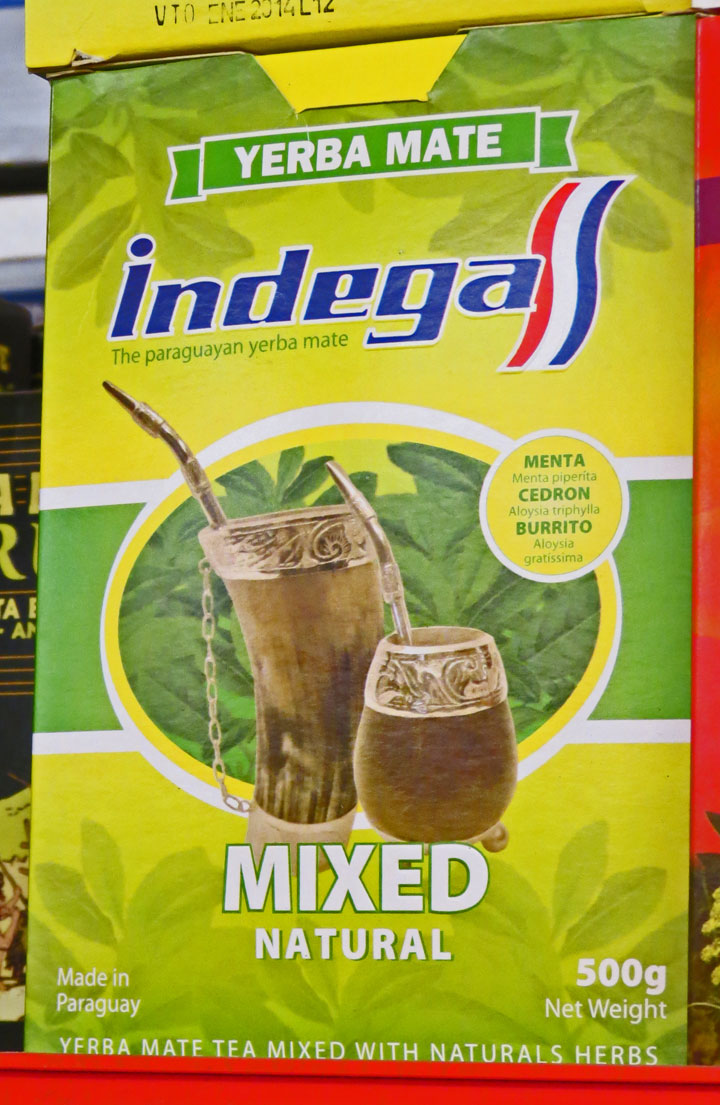
Mate is traditionally drunk in a particular social setting, such as family
gatherings or with friends. The same gourd (cuia) and straw (bomba/bombilla) are
used by everyone drinking. One person (known in Portuguese as the preparador,
cevador or patrão, and in Spanish as the cebador) assumes the task of server.
Typically, the cebador fills the gourd and drinks the mate completely to ensure
that it is free of particulate matter and of good quality. In some places
passing the first brew of mate to another drinker is considered bad manners, as
it may be too cold or too strong; for this reason the first brew is often called
mate del zonzo (mate of the fool). The cebador subsequently refills the gourd
and passes it to the drinker to his or her right, who likewise drinks it all,
without thanking the server. It is possible that the cebador drinks the second
filling as well, if he or she deems it too cold or bitter. When there is no more
tea, the straw makes a loud sucking noise, that is not considered rude. The
ritual proceeds around the circle in this fashion until the mate becomes lavado
("washed out" or "flat"), typically after the gourd has been filled about ten
times or more depending on the yerba used (well-aged yerba mate is typically
more potent, and therefore provides a greater number of refills) and the ability
of the cebador. When one has had his fill of mate, he or she politely thanks the
cebador passing the mate back at the same time. When someone takes too long,
others in the roda (Spanish: "ronda"; English: "round") will likely friendly
warn him or her by saying "bring the talking gourd" (cuia de conversar); an
Argentine equivalent, especially among young people, being "no es un micrófono"
("it's not a microphone"), an allusion to the drinker holding the mate for too
long, as if they were using it as a microphone to deliver a lecture.
Some drinkers like to add sugar or honey, creating mate dulce (sweet mate),
instead of sugarless mate amargo (bitter mate). It is considered bad for the
gourd (especially for the natural (squash or wood) ones) to be used for mate
dulce so it is normal for households with drinkers of both kinds to have two
separate gourds. It is also often considered proper only for children and women,
not for adult men, though this is becoming quickly obsolete.
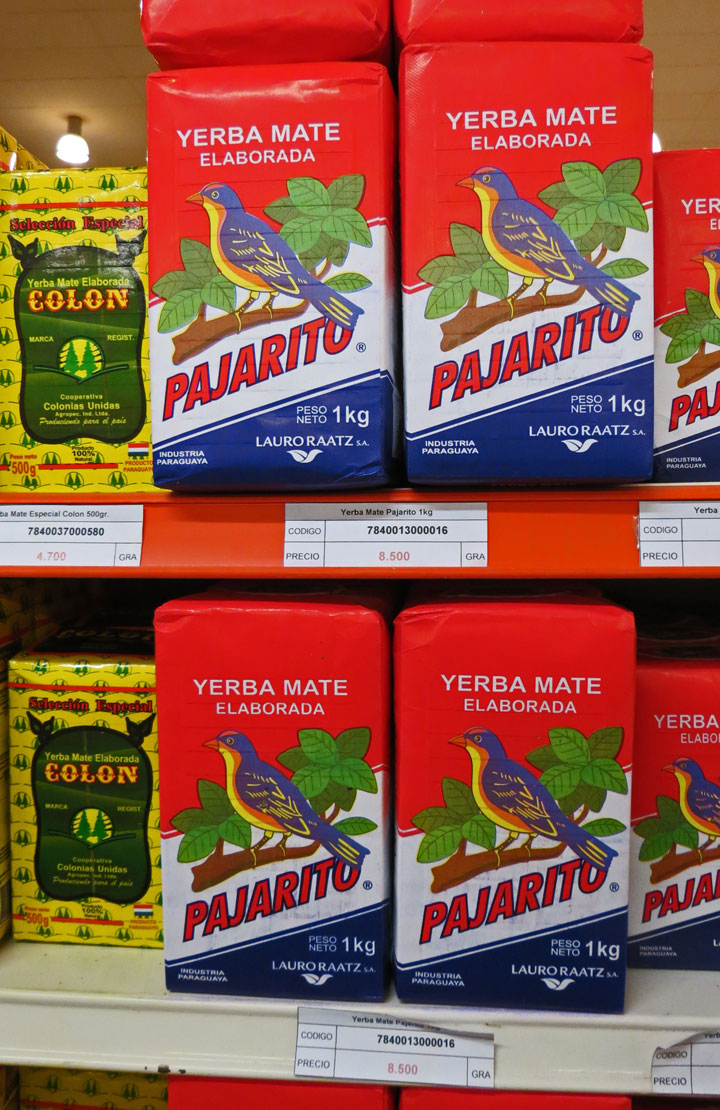
Traditionally, natural gourds are used, though wood vessels, bamboo tubes and
gourd-shaped mates, made of ceramic or metal (stainless steel or even silver)
are also common. The gourd is traditionally made out of the porongo or cabaça
fruit shell. Gourds are commonly decorated with silver, sporting decorative or
heraldic designs with floral motifs.
Mate was first consumed by the indigenous Guaraní and also spread by the Tupí
people that lived in Southern Brazil, that was Paraguayan territory before the
war of the Triple Alliance. Therefore, the scientific name of the yerba mate is
Ilex paraguariensis. The consumption of mate became widespread with the European
colonization. The consumption of yerba mate became widespread in the Spanish
colony of Paraguay in the late 16th century both among Spanish settlers and
indigenous Guaraní, who consumed it before the Spanish arrival. Mate consumption
spread in the 17th century to the River Plate and from there to Chile, Bolivia
and Peru. This widespread consumption turned it into Paraguay's main commodity
above other wares like tobacco, cotton, and beef. Aboriginal labour was used to
harvest wild stands. In the mid 17th century Jesuits managed to domesticate the
plant and establish plantations in their Indian reductions in the Paraguayan
department of Misiones, sparking severe competition with the Paraguayan
harvesters of wild strands. After their expulsion in the 1770s, the Jesuit
missions - along with the yerba mate plantations - fell into ruins. The industry
continued to be of prime importance for the Paraguayan economy after
independence, but development in benefit of the Paraguayan state halted after
the War of the Triple Alliance (1864–1870) that devastated the country both
economically and demographically.
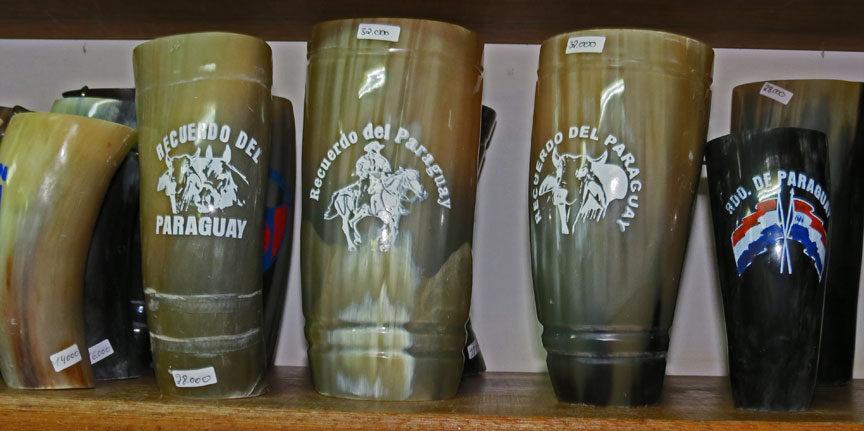
horm Mate bowl for tourists
Brazil then became the largest producer of mate. In Brazilian and Argentine
projects in late 19th and early 20th century the plant was domesticated once
again, opening the way for plantation systems. When Brazilian entrepreneurs
turned their attention into coffee in the 1930s, Argentina, which had long been
the prime consumer, took over as the largest producer, resurrecting the economy
of Misiones Province, where the Jesuits had once had most of their plantations.
For years the status of largest producer shift between Brazil and Argentina.
Today, Brazil is the largest producer with 53%, followed by Argentina, 37% and
Paraguay, 10%.
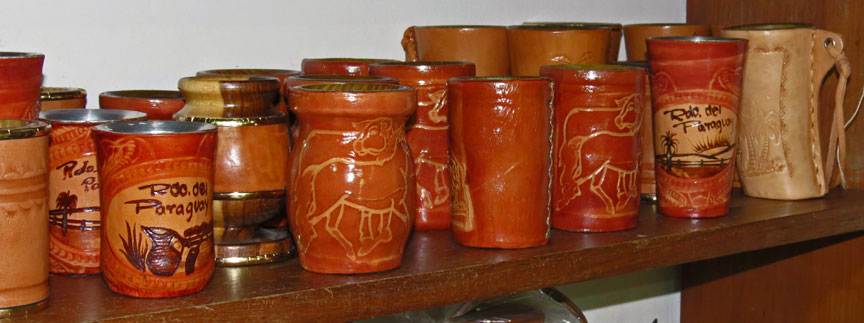
ceramic Mare bowls
Mate is the national drink of Argentina, Paraguay, where it is also consumed
with either hot or ice cold water (see tereré), and Uruguay. Drinking mate is a
common social practice in parts of Brazil, Chile, eastern Bolivia. Throughout
the Southern Cone, it is considered to be a tradition typical of the Gauchos or
vaqueros, terms commonly used to describe residents of the South American
pampas, chacos, or Patagonian grasslands, found principally in parts of
Argentina, Paraguay, Uruguay, Southern Chile, and southern Brazil.
Drinking the yerba mate is considered to be more than just good for the body;
it's also considered to be good for the soul. Drinking it can be a form of
meditation or reflection - allowing the goodness to infuse into the body while
stimulating and resting the mind. Those who share the mate join in a kind of
bond of total acceptance and friendship. Generally the server will start a new
infusion and then take the first drink. This is considered an act of kindness by
the other people in the circle, because usually the first serving is considered
the worst.
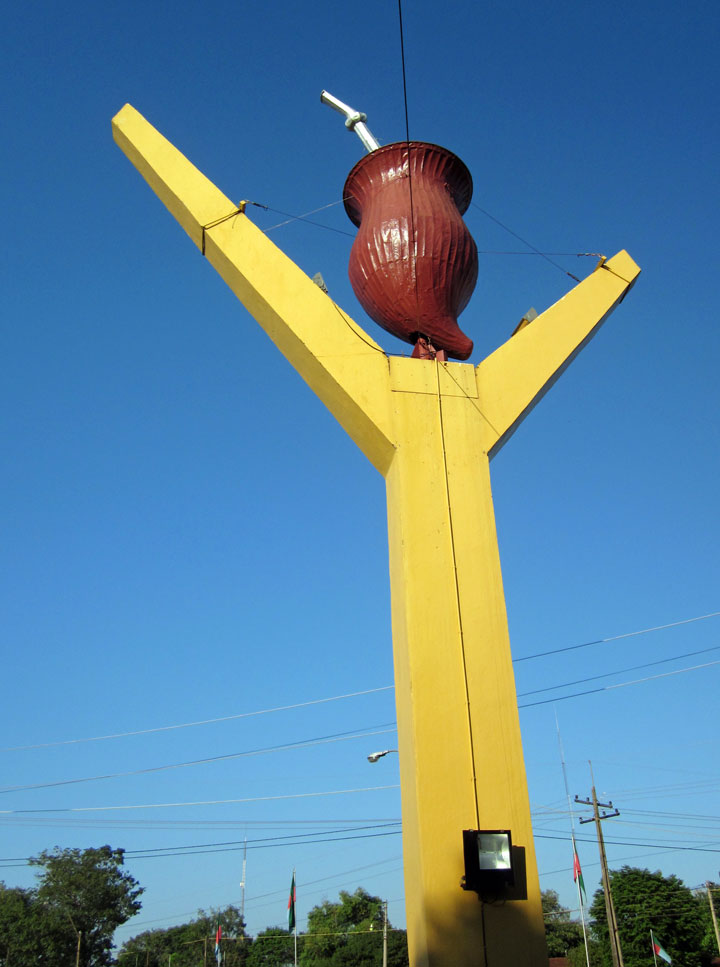
Mate statue in Bella Vista
Both the wood vessels and the gourds must undergo curing to get a better taste
before being used for the first time and to ensure the long life of the gourd.
Typically, to cure a gourd, the wet inside is first scraped with the tip of a
teaspoon to remove loose gourd particles. Mate herb and hot water is added next,
and the mixture poured into the gourd. The mixture is left to sit overnight and
the water is topped off periodically through the next 24 hours as the gourd
absorbs the water. Finally the gourd is scraped out, emptied, and put in
sunlight until completely dry. Drying the gourd near a Parrilla (barbecue grill)
is common in Argentina or Uruguay and adds a smokey flavor to the gourd.
Like other caffeine-rich infusion, such as coffee and tea, mate is generally
recognized as safe by the United States Food and Drug Administration.
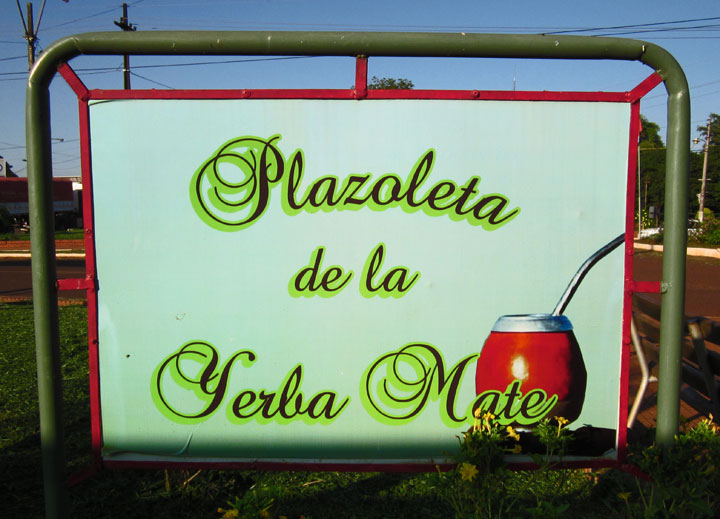
in Mate plaza
Mate tea contains several vitamins and minerals important to human health,
including vitamins A (as beta-carotene), B1, B2, C and E, as well as phosphorus,
iron and calcium.
Yerba mate tea contains significant levels of polyphenol antioxidants, and has a
slightly higher antioxidant capacity than green tea. On average, mate tea
contains 92 milligrams of the antioxidant chlorogenic acid per gram of dry
leaves, and no catechins, giving it a significantly different antioxidant
profile than other teas.

Mate kit
hot water container with Mate bowl holder
In-vivo and in-vitro studies are showing that yerba mate exhibits significant cancer-fighting activity. In 1995, research at the University of Illinois found yerba mate to inhibit the proliferation of oral cancer cells.
Researchers in Mississippi found that both cold and hot water extractions of
popular commercial yerba mate products contained high levels (8.03 to 53.3 ng/g
dry leaves) of carcinogenic polycyclic aromatic hydrocarbons (PAHs) (i.e.
Benzo[a]pyrene). However, these potential carcinogenic compounds originate from
commercial drying process of the mate leaves, which involves smoke from the
burning of wood, much like polycyclic aromatic hydrocarbons found in wood smoked
meat. "Un-smoked" or steamed varieties of yerba mate tea are available which may
reduce this risk, though research comparing relative cancer risks of smoked
versus steamed yerba mate is not available. One study found that the antioxidant
properties of mate tea remain the same between both smoked and un-smoked
varieties.
Other studies have highlighted limited evidence showing an association between
esophageal cancer and hot mate drinking. Some research has suggested that this
effect is almost entirely a consequence of hot mate's temperature; similar links
to cancer have been found for tea and other beverages generally consumed at high
temperatures. While drinking mate at very hot temperatures is considered as
"probably carcinogenic to humans" on the IARC Group 2A carcinogens list, mate
itself is not classifiable as to its carcinogenicity to humans.
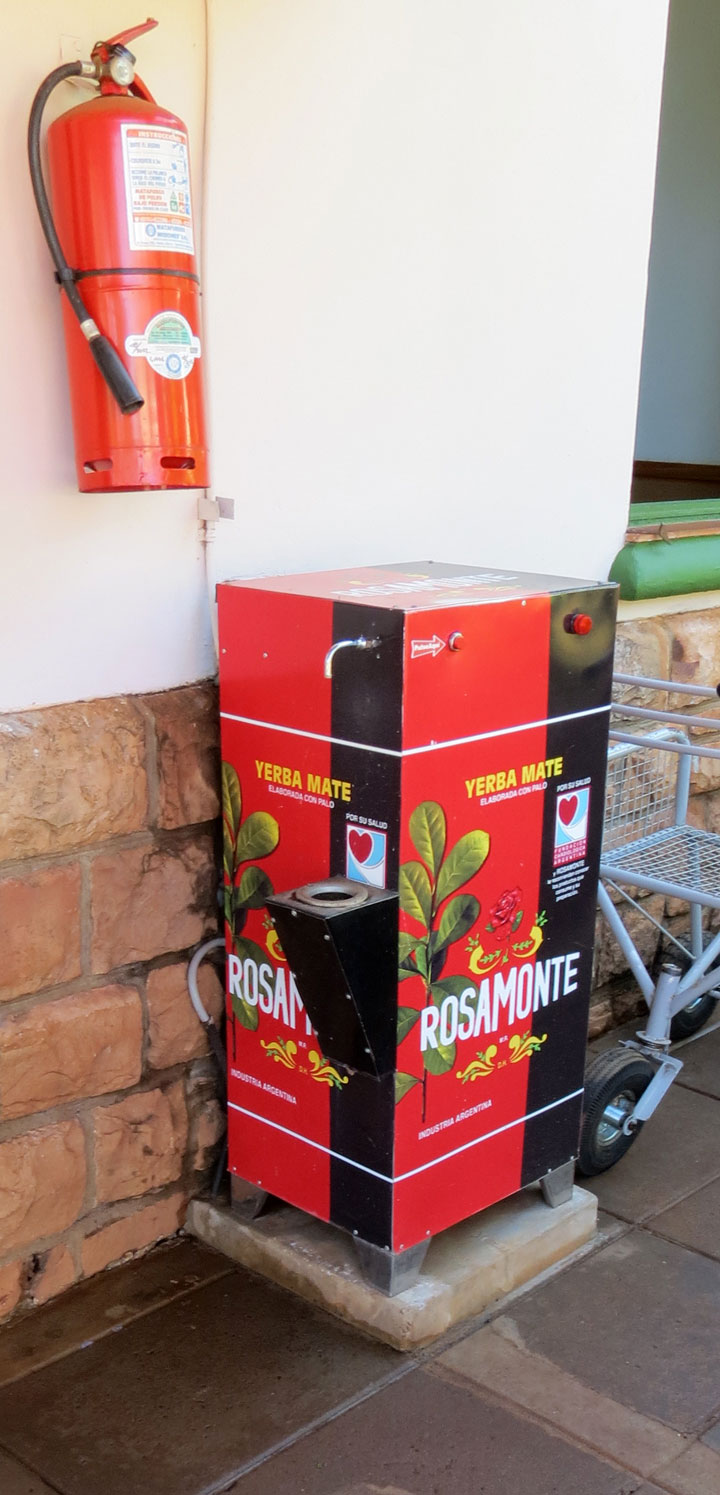
Yerba Mate vending machine
One study found a link between mate consumption and increased risk of bladder
cancer, although the increased risk was relatively similar to the risks
associated with the consumption of other common caffeinated beverages such as
coffee and tea.
One study found an increased risk for lung cancer. Another study associated mate
drinking with the development of non-Hodgkin lymphoma.
A 2007 study from the University of Illinois conducted by Elvira de Mejia Ph.D,
(Plant Biotechnology) found that consuming 0.5 liters of yerba mate tea
increases activity levels of the enzyme that produces HDL cholesterol, and
lowers levels of LDL cholesterol. Study participants drinking mate tea had a 10%
increase in the level of cardioprotective enzyme PON1, a precursor to HDL,
compared to others drinking milk or coffee.
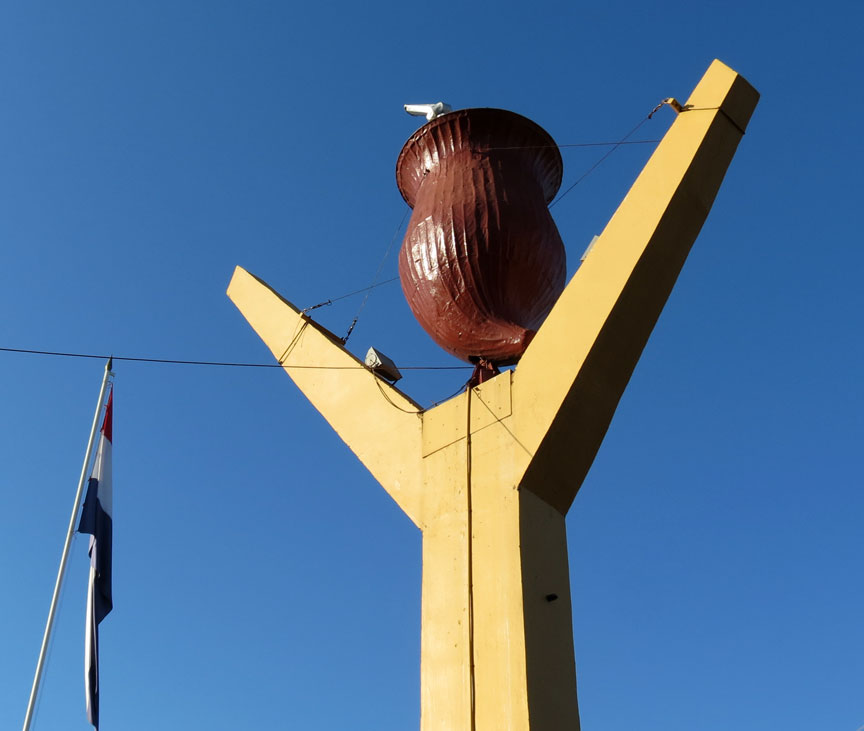
An in vivo study conducted by the University of São Francisco and the University
of São Paulo in Brazil in 2009 found that mice fed high-fat diets for 12 weeks
had significant improvements in blood serum levels of cholesterol, triglycerides,
LDL cholesterol, and glucose after being orally administered a solution of
purified water and instant yerba mate tea powder.
The Guaraní (Guarani, in Portuguese) people started drinking mate in Paraguay,
region that currently includes Paraguay, southern Brazil, south-eastern Bolivia,
north-east Argentina, and Uruguay. The Guaraní have a legend that says that the
Goddesses of the Moon and the Cloud came to the Earth one day to visit it but
they instead found a Yaguareté (a jaguar) that was going to attack them. An old
man saved them, and, in compensation, the Goddesses gave the old man a new kind
of plant, from which he could prepare a "drink of friendship".
Text from Wikipedia